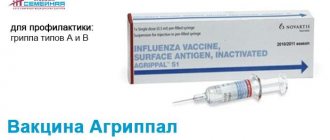Vaxigrip® Tetra vaccine is indicated for the prevention of influenza caused by the two subtypes of influenza A virus and the two types of influenza B virus contained in this vaccine, for:
- active immunization of adults, including pregnant women, as well as children over 6 months of age;
- passive protection of infants under 6 months of age whose mothers were vaccinated during pregnancy (see Sections “Peculiarities of use”, “Use during pregnancy or lactation” and “Immunological and biological properties”).
Vaxigrip® Tetra should be used according to official recommendations.
Compound
Influenza, inactivated, split virus;
The composition of the Vaxigrip® Tetra vaccine complies with WHO recommendations and the decision of the European Union on the composition of influenza vaccines for the 2020/2021 season for the Northern Hemisphere;
1 immunizing dose of vaccine (0.5 ml) contains
Active ingredients:
inactivated split influenza virus of the following strains*:
A/Guangdong-Maonan/SWL1536/2019 (H1N1) pdm09 - similar
(A/Guangdong-Maonan/SWL1536/2019, CNIC-1909) - 15 µg GA **
A/Hong Kong/2671/2019 (H3N2) - shaped (A/Hong Kong/2671/2019, IVR-208) - 15 µg HA **
B/Phuket/3073/2013 - shaped (B/Phuket/3073/2013, wild type) - 15 mcg GA **
B/Washington/02/2019 - shaped (B/Washington/02/2019, wild type) - 15 mcg GA **
* Cultivated on chicken embryos of healthy chickens;
** hemagglutinin;
Excipients: buffer solution (sodium chloride, sodium phosphate, dihydrate; potassium dihydrogen phosphate; potassium chloride and water for injection).
Composition and release form
The drug is released in the form of a sterile suspension, which is a colorless, slightly opalescent liquid intended for parenteral administration.
Vaxigrip Tetra is dispensed in a disposable syringe with a volume of 0.5 ml, one piece in each package. Pharmacy chains offer options with and without a pre-installed needle.
The active ingredient of the drug is a combination of hemagglutinins from four influenza strains, which is reflected in the name by the word “Tetra”. All strains of the virus were grown on chicken embryos.
The vaccine contains the following inactivated strains of the pathogen:
- Texas, or influenza A H3N2-like;
- Brisbane, or influenza A H1N1 pdm09-shaped;
- Colorado, or flu In the Victoria line;
- Phuket, or flu In the Yamagata line.
One dose of the product contains 15 mcg of hemagglutinins for each of the above influenza strains.
To maintain the dosage form and maintain the activity of the drug, manufacturers used excipients, namely: sodium chloride, sodium hydrogen phosphate dihydrate, potassium dihydrogen phosphate, potassium chloride and injection water.
Features of application
Pregnant
Vaxigrip® Tetra can be used throughout pregnancy.
Children
Vaxigrip® Tetra is prescribed to children aged 6 months and older (see Section “Method of administration and dosage”).
The safety and effectiveness of the Vaxigrip® Tetra vaccine in children under 6 months of age have not been established.
Drivers
The effect of the Vaxigrip® Tetra vaccine on the ability to drive vehicles or operate machinery is absent or insignificant.
Indications and contraindications for use
The main indication for the use of the influenza vaccine Vaxigrip Tetra is vaccination against influenza A and B in children over 6 months of age, adolescents and adults.
Active immunization is regulated by orders and protocols of the Ministry of Health.

Contraindications to vaccination with this drug are the following:
- history of allergy to Vaxigrip Tetra;
- individual intolerance to the active components of the drug;
- individual intolerance to the components of the buffer solution (sodium chloride, sodium hydrogen phosphate dihydrate, potassium dihydrogen phosphate, potassium chloride and injection water);
- individual intolerance to substances used in the manufacture of the vaccine - chicken eggs, the antibiotic neomycin, formic acid and octoxynol-9;
- conditions that are accompanied by a temperature rise above 38 degrees Celsius.
Contraindications to immunoprophylaxis are determined by the attending physician.
Side effects
Most adverse reactions typically occurred within the first 3 days after vaccination and resolved spontaneously within 1 to 3 days after occurrence. The intensity of these reactions was mild.
The most common adverse reaction following vaccination reported in all populations, including children 6 to 35 months of age, was pain at the injection site (52.8% to 56.5% in children 3 to 17 years of age and adults , 26.8% in children aged 6 to 35 months and 25.8% in the elderly).
In the subpopulation of children under 24 months, irritability was a common adverse reaction (32.3%).
In the subpopulation of children aged 24 to 35 months, malaise was the most commonly reported condition (26.8%).
Caution and application features
The drug is intended exclusively for injection into the subcutaneous tissue or muscle. It is strictly forbidden to administer the vaccine intravenously, as this may lead to negative health consequences.
Vaxigrip Tetra is used with caution in patients with bleeding diathesis and thrombocytopenia, since injection of the drug can provoke bleeding.
Any vaccination, including the flu, can cause fainting, which occurs as a result of a psychogenic reaction to the injection. Considering this, during the injection of the drug the patient should sit on the couch to avoid injury.
Use during pregnancy or breastfeeding
The influenza vaccine Vaxigrip Tetra contains inactivated strains of the virus, so it can be used to immunize pregnant women. But the manufacturer recommends using the drug in the second and third trimesters of pregnancy, since there is an evidence base for the safety of the vaccine in these periods of gestation. All studies were conducted on animals and did not reveal any harmful effects on the fetus. The final decision on the admissibility and advisability of influenza vaccination is made by the obstetrician-gynecologist observing the patient.

The drug is also safe for newborns, so it can be used to vaccinate women during lactation and breastfeeding.
In childhood
The drug is used for active immunization of children from six months of age. Vaxigrip Tetra is not used for vaccination of children under six months of age, since there is no evidence base on the safety and effectiveness of this vaccination.
The ability to influence the reaction rate when driving vehicles or other mechanisms
The flu vaccine Vaxigrip Tetra does not affect the reaction speed and does not reduce attention, so after vaccination you can drive a car or work with complex machinery.
Interaction with other drugs and other types of interactions
The formation of the immune response is not affected by antiviral and antibacterial therapy. The drug can also be used simultaneously with other non-live vaccines, but the injections must be performed in different areas of the body.
The production of antibodies to the influenza virus can be affected by anticancer therapy, immunosuppressants and glucocorticosteroid hormones.
Storage conditions
Keep out of the reach of children.
Store in the refrigerator (2 - 8°C). Do not freeze.
Store the syringe in the outer cardboard box to protect the drug from light.
Do not use after the expiration date stated on the packaging.
The expiration date is considered to be the last day of the month indicated on the packaging.
Shelf life: 1 year.
Product description certified by the manufacturer Sanofi
.
Verified by
Likar Turumkulova Irina
Storage conditions and periods
The flu vaccine Vaxigripp Tetra must be stored under the following conditions:
- in original packaging,
- in a refrigerator,
- at storage temperatures from 2 to 8 degrees Celsius,
- can't be frozen
- in a place inaccessible to children.
Transportation of the drug should take place in a container or cooler bag with cold elements that maintain acceptable storage temperatures. Failure to comply with the above rules will result in the vaccine becoming unusable.
The drug is valid for 12 months from the date of release, the date of which the manufacturer indicates both on the packaging and on the syringe itself. Using expired vaccines is hazardous to health.
Note!
Description of the drug Vaxigrip tetra split vaccine for prof. influenza susp. d/in. 0.5 ml syringe with needle No. 1 on this page is a simplified author’s version of the apteka911 website, created on the basis of the instructions for use.
Before purchasing or using the drug, you should consult your doctor and read the manufacturer's original instructions (attached to each package of the drug). Information about the drug is provided for informational purposes only and should not be used as a guide to self-medication. Only a doctor can decide to prescribe the drug, as well as determine the dose and methods of its use.
Overdose and side effects
Adverse reactions after using the drug occur extremely rarely. Most often, patients note cephalgia, general malaise, myalgia, hyperhidrosis, increased fatigue, chills, and increased body temperature. In addition, local side effects may occur in the form of pain, skin hyperemia, edema, hematoma and infiltration in the injection area. Local reactions usually go away on their own within 1-2 days and require medical attention.

The manufacturer also warns about the risk of developing the following adverse reactions:
- allergic reactions - rash, generalized erythema, anaphylactic shock, Quincke's edema;
- from the peripheral and central nervous system - dizziness, irritability, depression, inflammation of peripheral nerves, encephalitis, convulsive syndrome, Guillain-Baré syndrome, sleep disturbance;
- from the digestive system - loss of appetite, nausea, vomiting, abdominal pain, bowel dysfunction;
- from the blood and blood vessels - decreased platelet levels, vasculitis.
If at least one of the listed adverse reactions occurs, you should consult your doctor. In turn, the doctor registers the side effect, fills out an electronic report card about the adverse reaction and sends it to Pharmanadzor.
There have been no cases of overdose with the Vaxigrip Tetra vaccine. Since the injection procedure is carried out within the walls of a medical institution, under the supervision of a medical professional, the likelihood of an overdose is extremely low. It is assumed that when the recommended dose is exceeded, side effects increase.
Possible reactions
In most cases, the Vaxigrip vaccine is well tolerated by both adults and children. But in some cases, adverse reactions are possible. What might be the reaction to the Vaxigrip vaccine?
Common side effects:
- temperature increase;
- chills;
- deterioration of health, fatigue;
- muscle pain, joint aches;
- increased sweating;
- headache.
The listed reactions are not dangerous and do not require seeking medical help. Children may also experience swelling, redness or bruising at the injection site, and pain that goes away on their own.
In rare cases, more serious reactions occur after vaccination:
- neuralgia, other neurological disorders;
- fever and convulsions;
- skin rash, itching of the skin;
- rapid development of an allergic reaction up to Quincke's edema;
- goosebumps, tingling sensation in the body and decreased or loss of sensation;
- asymmetrical enlargement of two or more lymph nodes;
- transient thrombocytopenia.
If one of the listed disorders occurs after vaccination, emergency medical attention is required; you should immediately seek help from a doctor.
How is the flu vaccination carried out?
Flu vaccination is carried out in compliance with standard measures:
- examination by a doctor (generalist, pediatrician) before vaccination;
- laboratory tests (according to indications).
You can get vaccinated against the flu at any time, but it is advisable to take care of prevention before the onset of an unfavorable epidemic period (early October-November), since immunity against viruses in the body is formed up to 3 weeks.
Vaccination of children under 9 years of age who have not previously received a flu vaccine is carried out twice with an interval of 1 month. The doctor observes the patient during vaccination and monitors his condition after the procedure.
Indications and contraindications for vaccination in adults
Indications for vaccination for adults primarily concern people at risk:
- pregnant women and elderly people;
- having chronic diseases - cardiovascular and respiratory pathologies, kidney and liver diseases, malformations of the central nervous system;
- often suffering from acute respiratory infections;
- with weakened immunity (patients with HIV and undergoing chemotherapy and steroid therapy);
- doctors, teachers, service workers who constantly communicate with a large number of people.
Contraindications for vaccination in adults are due to the presence of concomitant diseases and pathological conditions:
- relapses of chronic diseases;
- undergoing a course of chemotherapy that suppresses the immune system;
- manifestation of acute allergic reactions to the main components of the drug.
Low-grade fever and mild signs of illness do not prevent vaccination for adults.









